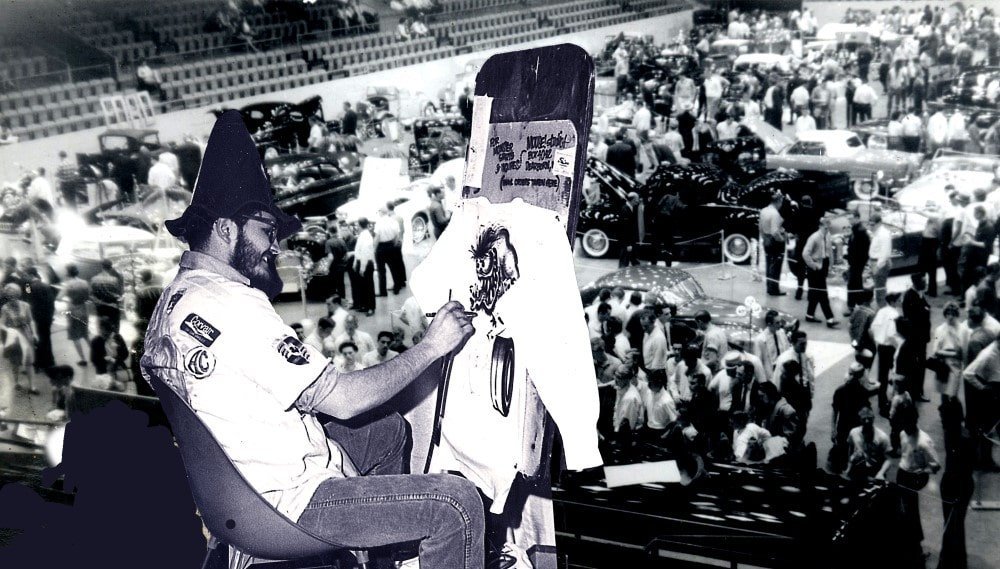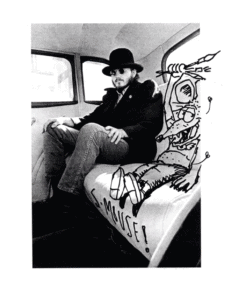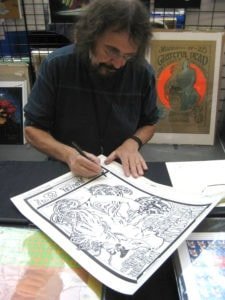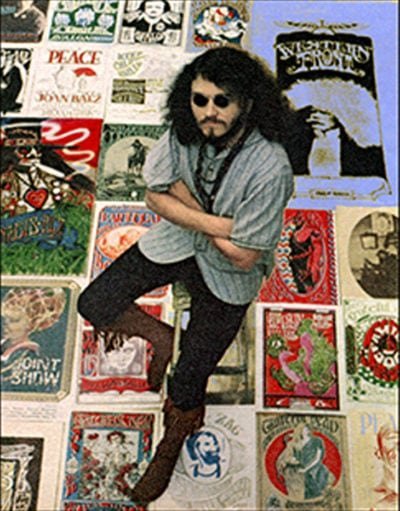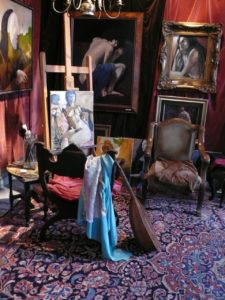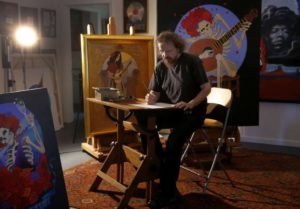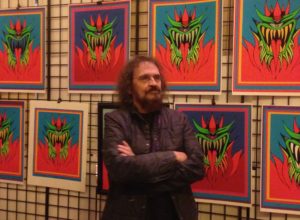
Of all the great visual artists who have been associated with the music in one way or another over the years, none have been more rock and roll than Stanley Mouse. Not only does his art go straight to the heart of the maverick music, but he has produced some of the most lasting visual images in rock history. But, more than that, it is Mouse himself whose life has been straight out of the music.
Often with his partner Alton Kelley, sometimes on his own, starting in June 1966, Mouse created twenty-six of the next thirty-six posters for weekly dances thrown by Chet Helms’ Family Dog at the Avalon Ballroom. Along with the other pioneering psychedelic poster artists of San Francisco that year – Wes Wilson, Victor Moscoso, Rick Griffin – these artists brought back their images from the realms of LSD. They made posters that looked like the music sounded.
Mouse was the most spectacularly pixilated by the scene. Dressed in vintage military uniforms covered with braid and medals, long-haired, bearded Mouse stomped his way through the tribal dance/concerts, dancing, carrying on, in the front of the hall or backstage. But Mouse’s journey had always been a rock and roll story.
Mouse was the most spectacularly pixilated by the scene. Dressed in vintage military uniforms covered with braid and medals, long-haired, bearded Mouse stomped his way through the tribal dance/concerts, dancing, carrying on, in the front of the hall or backstage. But Mouse’s journey had always been a rock and roll story.
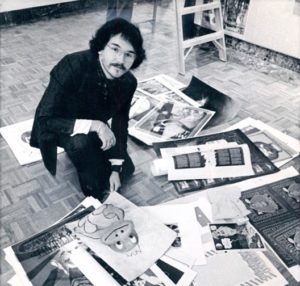
He grew up in Detroit where he was expelled from high school because he decided to paint some unsolicited images on the wall of a freshly white-painted restaurant and hangout across the street from his school. His downfall came because he signed his work. From the start, Mouse understood art should be subversive. Instead of going back to high school, he enrolled in the Detroit School for the Society of Arts and Crafts, but soon tired of the life drawing and abstract painting classes and concentrated on his own Monster art.
He pin-striped and painted flames on hot rods and air-brushed cartoon characters — crazed monsters with gear shifts in their hands atop fantasy vehicles — on sweat shirts he sold every weekend at county fairs, drag races and car shows. He developed a healthy mail order business. In 1963, he started Mouse Studios with his parents to handle sales of his designs (Mouse’s father was a sign painter and animator who had worked on “Snow White and the Seven Dwarfs”).
Immersed in the Detroit car culture, Mouse was working in the same underground movement as Southern California artist Ed “Big Daddy” Roth, a kind of authentic folk art that would be celebrated by journalist Tom Wolfe in his essay “Kandy-Kolored Tangerine-Flake Streamline, Baby.” At the height of his automotive period, Monarch Models used some of Mouse’s most popular work for their model car kits.
San Francisco called Mouse and, after returning to Detroit to solve his issues with the draft, he settled in the city just as the emerging scene was exploding. He had met Al Kelley at the notorious Pine Street commune, where Kelley sat atop a giant pile of trash in an otherwise empty room, speed-rapping while an AM radio played in the background. Mouse was immediately taken. They walked through the financial district together in full Edwardian finery, their locks flowing in the breeze, passing through crowds of people with short hair and gray suits. “There could be as many as a thousand people like us in San Francisco,” Kelley told Mouse.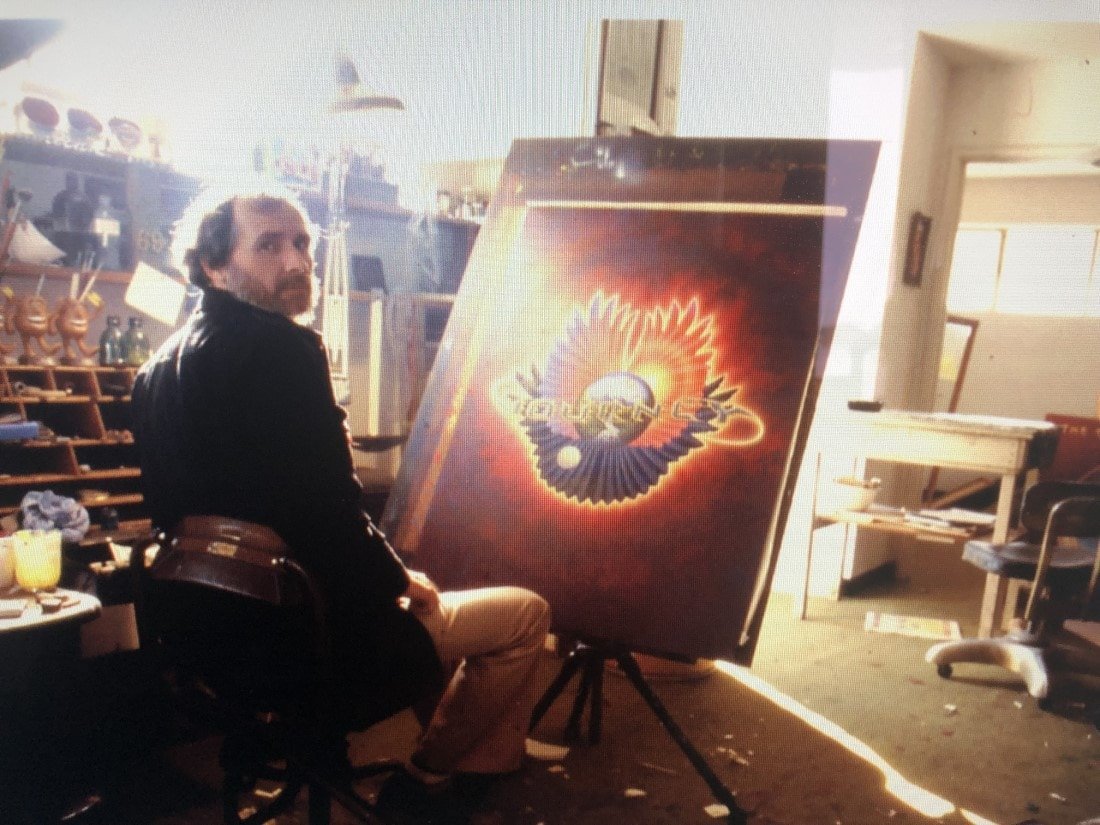
With new groups like Jefferson Airplane, Grateful Dead, Big Brother and the Holding Company or Quicksilver Messenger Service springing up and weekly dances at the Avalon, the Fillmore Auditorium or other clubs and halls around town, the scene was on fire. This was before underground newspapers or free-form rock radio, so the only way to announce and advertise these events was through posters that would be displayed in shop windows and café bulletin boards. Mouse quickly realized he could find a place for himself.
Mouse Studios, located in an old firehouse on Henry Street in the Castro district, was one of the central headquarters of the hippie world. They kept supplies of liquid LSD in the refrigerator. When Janis Joplin arrived in San Francisco to join Big Brother and the Holding Company, she was directed to report to Henry Street for her first rehearsal with the band. Police were called when neighbors heard a woman screaming.
Essentially, Kelley concentrated on design and layout, while Mouse did the drawing, although specific jurisdictions and responsibilities might not have been all that clearly defined. Right-handed Mouse and left-handed Kelley worked on the same easel together. They haunted the art files of the San Francisco Public Library, where they found artwork by Art Deco illustrator Alphonse Mucha or Native American portraits by photographer Edward Curtis they would incorporate in their posters. That was also where they found the skull and roses illustration for a vintage edition of “The Rubaiyat of Omar Khayyam” that would become one of their most enduring images after they associated the drawing with the Grateful Dead for an Avalon poster.
Mouse, Kelley and the other San Francisco poster artists led a graphic revolution that upended the world of visual arts. They were the most important poster artists since Toulouse Lautrec chronicled café society in nineteenth-century Paris. Throughout it all, Mouse’s steady hand and literate eye can be seen shaping many of the enduring posters of the era.
He bailed on San Francisco when Eric Clapton of Cream, his favorite group at the time, invited him to London to pin-stripe and flame his Rolls Royce. He spent some time in New Mexico working at producing fine art paintings, but soon returned to the clarion call of the music. He provided the Grateful Dead with album covers like “Workingman’s Dead,” “Europe ‘72” or “Terrapin Station.” He drew the Pegasus logo for the Steve Miller Band that adorned the seventeen-million-selling greatest hits album. He devised the scarabs that decorated all the Journey albums and stage designs.
All along, with his mix of irreverent humor, outlandish images, fearless freehand, bold lettering and inflammatory script, Mouse has drawn on the very same resources that also feed the heart of rock music. His art drinks at the same trough as the music. His art is music on paper. High above them, Stanley Mouse and the musicians are tapping the same inspiration and telling the same stories, but the musicians only play rock and roll. Mouse draws it.
— Article by Joel Selvin https://www.bluerosemusic.com/artist/the-mouse-that-rocked/

